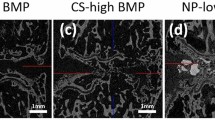Abstract.
Growth factors have proven to promote spine fusion. However, no comparative evaluation of growth factors in spinal fusion has yet been performed. The purpose of this study was to compare the efficacy and safety of combined IGF-I and TGF-ß1 application with BMP-2 application and autologous cancellous bone graft at an early time point in a sheep cervical spine fusion model. Thirty-two sheep underwent C3/4 discectomy and fusion. They were divided into four groups, according to their treatment: group 1, titanium cage (n=8); group 2, titanium cage filled with autologous cancellous iliac crest bone grafts (n=8); group 3, titanium cage coated with a poly-(D,L-lactide) (PDLLA) carrier including BMP-2 (5% w/w) (n=8); group 4, titanium cage coated with a PDLLA carrier including IGF-I (5% w/w) and TGF-ß1 (1% w/w) (n=8). Blood samples, body weight and temperature were analysed. Radiographic scans were performed pre- and postoperatively and after 1, 2, 4, 8 and 12 weeks. At the same time points, disc space height and intervertebral angle were measured. After 12 weeks, the animals were killed and fusion sites were evaluated using functional radiographic views in flexion and extension. Quantitative computed tomographic scans were performed to assess bone mineral density, bone mineral content and bony callus volume. Biomechanical testing was carried out and the values for range of motion, and neutral and elastic zone were determined. Histomorphological and histomorphometrical analysis were performed and polychrome sequential labelling was used to determine the time frame of new bone formation. The results showed that, in comparison to the group treated with the cage alone (group 1), the cage plus BMP-2 group (group 3) and the cage plus IGF-I and TGF-ß1 group (group 4) demonstrated a significantly higher fusion rate in radiographic findings, a higher biomechanical stability, a more advanced interbody fusion in histomorphometrical analysis, and an accelerated interbody fusion on fluorochrome sequence labelling. In comparison to the bone graft group (group 2), the BMP-2 (group 3) and IGF-I/TGF-ß1 group (group 4) showed significantly less residual motion on functional radiographic evaluation, higher bone mineral density of the callus and higher biomechanical stability in extension, rotation and bending. The BMP-2 group showed significantly less residual motion on functional radiographic evaluation and higher intervertebral bone matrix formation on fluorochrome sequence labelling at 9 weeks in comparison to the IGF-I/TGF-ß1 group. In contrast, the IGF-I/TGF-ß1 group showed a significantly higher bone mineral density of the callus than the BMP-2 group. In comparison to the autologous cancellous bone graft group, both growth factors (BMP-2 and combined IGF-I and TGF-ß1) significantly improved the biomechanical results of interbody fusion. No systemic side effects were observed for either growth factor. On the basis of these preliminary results, it would appear that combined IGF-I/TGF-ß1 application yields equivalent results to BMP-2 application at an early time point in anterior sheep cervical spine fusion.
Similar content being viewed by others
Author information
Authors and Affiliations
Additional information
Electronic Publication
Rights and permissions
About this article
Cite this article
Kandziora, .F., Pflugmacher, .R., Scholz, .M. et al. Comparison of BMP-2 and combined IGF-I/TGF-ß1 application in a sheep cervical spine fusion model. Eur Spine J 11, 482–493 (2002). https://doi.org/10.1007/s00586-001-0384-4
Received:
Revised:
Accepted:
Issue Date:
DOI: https://doi.org/10.1007/s00586-001-0384-4




